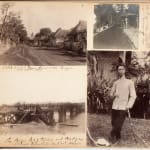Willis J. Raynor
Album of an Officer During the Philippine-American War, c. 1899
Photo album; Printing-out-paper and Silver prints (approx. 120)
5x7 inches and smaller.
Some with manuscript captions page recto.
Some with manuscript captions page recto.
Sold
Further images
-
(View a larger image of thumbnail 1
)

-
(View a larger image of thumbnail 2
)

-
(View a larger image of thumbnail 3
)

-
(View a larger image of thumbnail 4
)

-
(View a larger image of thumbnail 5
)

-
(View a larger image of thumbnail 6
)

-
(View a larger image of thumbnail 7
)

-
(View a larger image of thumbnail 8
)

Album of photographs pertaining to the Philippine-American war. A continuation of the struggle for independence that began with the Philippine Revolution in 1896, the Philippine-American War was waged between the...
Album of photographs pertaining to the Philippine-American war. A continuation of the struggle for independence that began with the Philippine Revolution in 1896, the Philippine-American War was waged between the United States and the First Philippine Republic after the Philippines was annexed at the conclusion of the Spanish American War.
The album begins taken stateside, a small mix of personal photographs, presumably family members of Major W.J. Raynor, the album’s compiler, and photographs of Fort Logan in Colorado, where he was stationed before traveling overseas, including the officers’ quarters, headquarters, guard’s house, and hospital. There is also one photograph of a group of women captioned, “army wives.”
The remainder of the album consists of photographs showing Raynor and other members of the 25th Infantry in the Philippines. These are a mix of personal and commercially-produced images. There are views of Manilla, Luzon, Bagabag, and Caloocan. About half of the photographs are captioned. Notably, there are a number of portraits of important people who participated in the Philippine Revolution, including Emilio Aguinaldo, Antonio Montenegro and Francisco Macabulos. Interesting personal photographs include a cyanotype interior view of the hospital ward in Iloilo, a scene of “Decoration Day at Corregidor” and a pair of photos “Easter singers who sang for Mrs. Raynor at her home in Valladolid.”
The album begins taken stateside, a small mix of personal photographs, presumably family members of Major W.J. Raynor, the album’s compiler, and photographs of Fort Logan in Colorado, where he was stationed before traveling overseas, including the officers’ quarters, headquarters, guard’s house, and hospital. There is also one photograph of a group of women captioned, “army wives.”
The remainder of the album consists of photographs showing Raynor and other members of the 25th Infantry in the Philippines. These are a mix of personal and commercially-produced images. There are views of Manilla, Luzon, Bagabag, and Caloocan. About half of the photographs are captioned. Notably, there are a number of portraits of important people who participated in the Philippine Revolution, including Emilio Aguinaldo, Antonio Montenegro and Francisco Macabulos. Interesting personal photographs include a cyanotype interior view of the hospital ward in Iloilo, a scene of “Decoration Day at Corregidor” and a pair of photos “Easter singers who sang for Mrs. Raynor at her home in Valladolid.”







